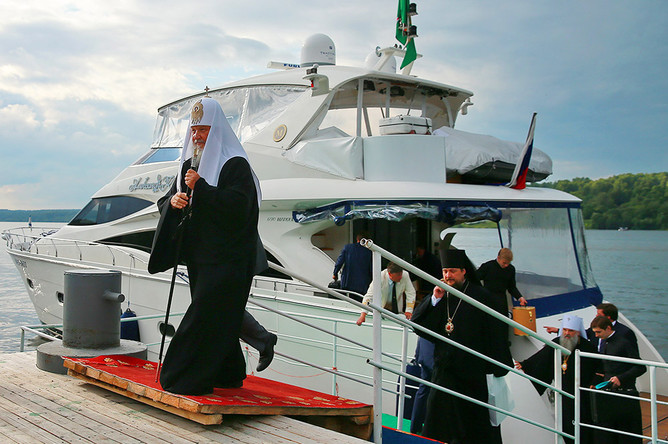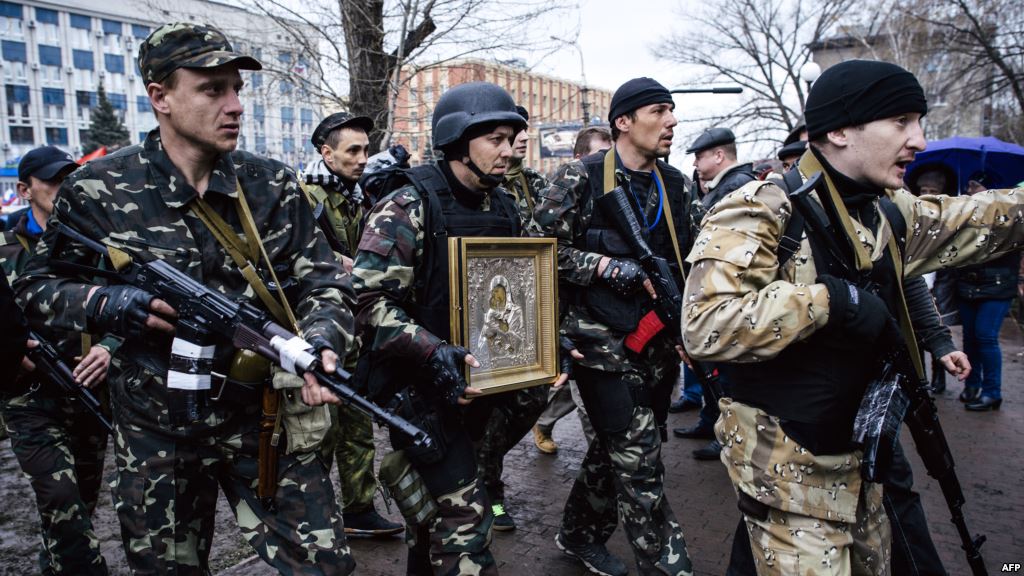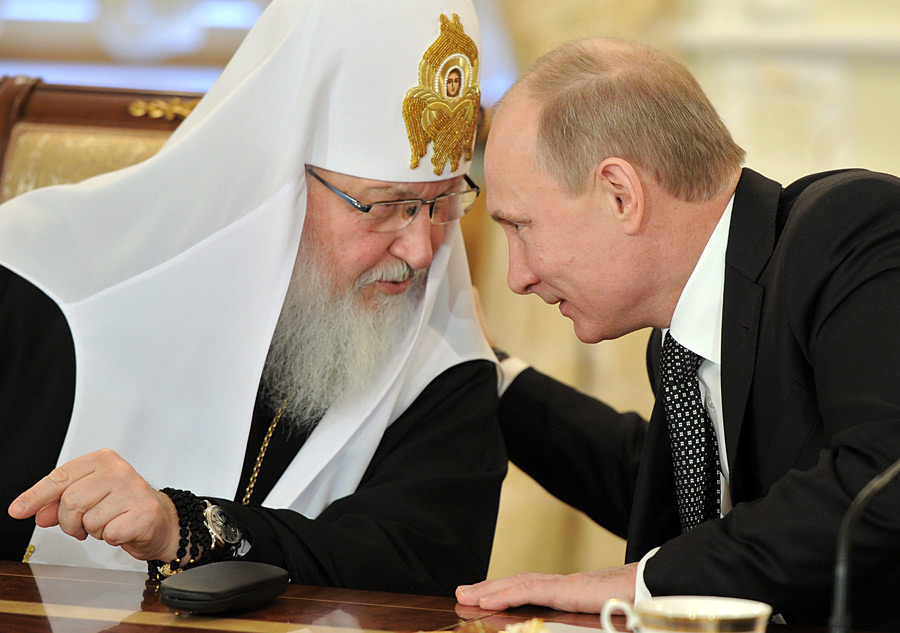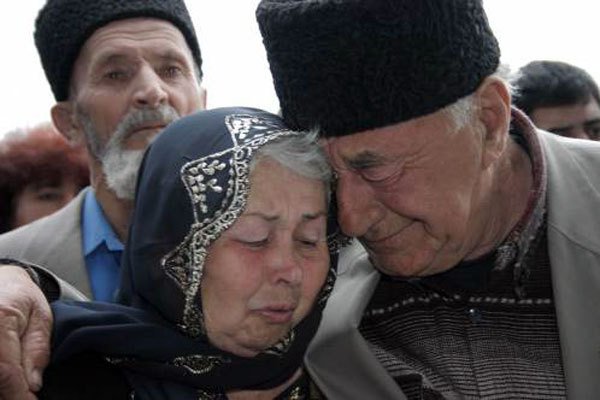The official involvement of the Russian Orthodox Church in the political process is so great, that in many ways it
has become an instrument of Russian foreign and domestic policy.
In discussing the Moscow Patriarchate Russian Orthodox Church (MPROC) in the context of modern foreign and domestic policy of Russia, it should be noted that, any large religious organization is a complex and multi-faceted mechanism that can hardly be clearly defined in terms of the political preferences of all its members.
However, we should recognize that at the moment the official involvement of the Russian Orthodox Church (first and foremost – its highest Church hierarchy) in the political process is so great, that the Church in many ways has become one of the common elements created by the Kremlin propaganda machine.
"Putin majority" percieves Church as a protection from "destructive soulless West"
For "Putin majority", the official Russian Orthodox Church now plays the role similar to the one played by the Communist Party during the late soviet stagnation years.
The degree of influence of propaganda on various groups of Russians on one hand and on foreign Orthodox or near-orthodox communities (residents of eastern Ukraine, the Balkans and the Christian minorities in the Middle East) on the other is somewhat different. Among Russians who consider themselves Orthodox, no more than 4% are seriously involved in religious life.
The bulk of the population goes to church only 2-3 times per year, does not know the content of the Christian faith, and does not plan to change their life patterns in order to follow the Orthodox canons. For these people, the official Russian Orthodox Church now plays the role similar to the one played by the Communist Party during the late soviet stagnation years.

This means that the so-called "Putin majority" doesn’t really take specific statements of high-ranking Church hierarchs seriously. While, as opposed to Brezhnev’s era, most people do take the state-run TV propaganda seriously and even express sincere enthusiasm, the speeches of MPRPC’s clergymen are looked at with a grain of salt. This majority is willing to be loyal to the Russian Orthodox Church when it, in their understanding, is "protecting the Russian identity from the aggression of the soulless West."
The sacralisation of war is pivotal for mobilizing and motivating the "radical orthodoxy", it provides a new and higher meaning to their actions.
They express sincere pride when Patriarch Kirill (Gundyaev) talks about the exclusiveness and a special "bogoizbrannost" (literally meaning "being chosen by God") or "spirituality" of the Russian people, but the same people become very annoyed and agitated, when they hear talk about abortion ban or introduction of bureaucratic hurdles for “civil couples” (couples not officially married).
However, in no way does the "Putin majority" question the leading role of the MPROC in the spiritual life of the country. They perceive the Church as a basis of national identity and state-forming institution and, therefore, a spiritual protection against the "destructive foreign influence". This is precisely why the MPRPC and its radical off-springs enjoy privileges and impunity on the part of the authorities.
Equal reverence for Church, Lenin monuments and war
These people are willing to approve art being vandalized by radical church activists not because these artworks in any way offend their "religious feelings", but just because "this is necessary." The same principle - that "it was necessary" was applied when it came to the destruction of imported foods (import substitution), or everyone pretended that "there are no Russian military troops in Donbas", even among those, for whom it was obvious to the contrary. Many sincerely believe that the “Gayeuropa” or the “evil Yankees” will come if the “national identity” is not asserted, and all measures, even as barbaric as these ones are good for the cause.
[youtube https://www.youtube.com/watch?v=4_P1U0OM3sk]
Accordingly, when these people are told about the threat to Orthodox shrines abroad (in Ukraine or the Balkans), for most Russians this fictitious "encroachment upon our sacred holy places" is perceived more as a blow to their self-identification, to the unofficial symbol Russia's presence and influence over Ukraine’s territory. A similar attitude, by the way, is observed with respect to the monuments to Lenin.
However, the religious propaganda specifically does play its role in mobilizing the "radical orthodoxy" too. The sacralisation of war is pivotal for motivating such people, it provides a new and higher meaning to their actions. This propaganda is especially effective on the poor and the marginalized, providing them with an effective escape from a depressed and hopeless hurdles of everyday life.
Church
's three foreign fronts: Eastern Ukraine, the Balkans, the Middle East
Speaking about Eastern Ukraine specifically, on the one hand the society in that region is less secular than in Russia. On the other hand, this region has a very small amount of "religious intellectuals." The percent of Orthodox believers who know the essence of the Christian faith in the Donbas is even lower than in Russia, and this region has no experience of establishing a centralized system of catechization at all. This authority of the priest is even higher than in Russia, as is the need for external religious rites.

Additionally, an interesting theme of the Ukrainian Orthodox Church (UOC MP) in Ukraine has for many years been the atmosphere of struggle, a constant conflict with the Kyiv Patriarchate, so the "religion of war" fell on fertile ground in Donbas. Due to all these factors, the percentage of populous who take the propaganda from the Russian Orthodox Church seriously in these regions can be even higher than in Russia itself. For some supporters of separatism from these regions the war against Kiev does carry a sacred element.
In the Balkans, the Russian influence through the church channels is arranged in a similar way. The focus here is on the sacralization of Serbian nationalism and employing scary tactics of external threats ("the destruction of the Orthodox shrines" by NATO, Albanians or Croats, the legalization of gay marriage and gay pride parades, juvenile justice and the general depravity of society).
MPROC is trying to convince the Christian minorities in the Middle East that their main defense is not just Russia itself, but also the often-tyrannical regime at power in that particular country (for example Syria).
Just as in Russia, the Orthodox Church of Serbia creates religious-mystic myths that are designed to justify territorial expansion. Thus, the legend of Serbian Kosovo Bojur (a flower that supposedly rose in the Kosovo field on the blood of the killed Serbian soldiers) is very similar to the myth of the "sacred Korsun" in the way it was built. This is joined with a constant rhetoric of a long-standing "brotherly friendship" between Russia and Serbia, and on that only Russia can save its fellow believers, who are trapped in a hostile environment. Thus, the Church is a quite powerful channel of influence for Russia in the Balkans.
Read more: Stalin and the Russian Orthodox Church
A somewhat different situation can be observed with the Christian minorities in the Middle East. This group of people needs no artificially created myths, because Christian communities in this region are feeling a very real threat from radical Muslim groups. Thus, the MPROC is trying to convince these people that their main defense is not just Russia itself, but also the often-tyrannical regime at power in that particular country (for example Syria). As a consequence, the Russian Orthodox Church uses its influence in these regions as a bargaining chip with the ruling regime: the church provides loyalty of religious minorities, and the government responds with friendly policies towards the Russian government.
The Russian Orthodox Church at the moment is an effective mechanism of promoting Russian policy within and outside its geographic borders. This tool is used to strengthen and increase the effectiveness of Russia's foreign policy, often – as a bargaining tool or to blackmail foreign governments.



